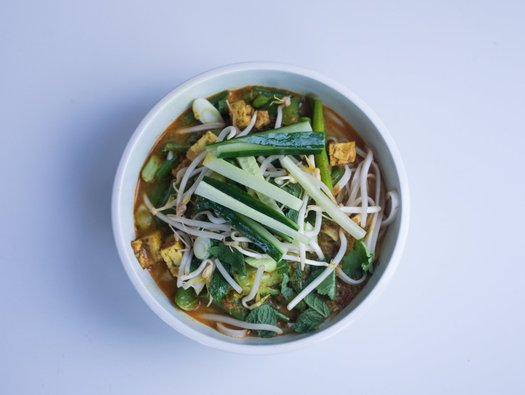Vegetable laksa with sugar snap peas and pak choi

A fresh soup, with plenty of flavour and fresh vegetables, yet low in salt, potassium and phosphate.

A fresh soup, with plenty of flavour and fresh vegetables, yet low in salt, potassium and phosphate.
1 tablespoon vegetable oil
2 small shallots, peeled and roughly sliced
2 garlic cloves, peeled and chopped
1 lemongrass stalk, just the white part chopped (keep the rest to flavour the soup)
20g ginger (or galangal, if you can find it), peeled and sliced
2 fresh red chillies, halved lengthways, seeds removed (if you do not want it too spicy) and sliced
1 sheet (approximately 18cm2 in size) of nori (toasted seaweed used for sushi), torn into small pieces
1 teaspoon ground turmeric
1 teaspoon ground coriander
½ teaspoon ground cumin
1 teaspoon sweet ground paprika
200g sugar snap peas, trimmed and any stringy bits removed, then cut in half diagonally
200g green beans, trimmed and cut in half horizontally
2 bulbs of pak choi, trimmed and roughly chopped
1 tablespoon vegetable oil
300g firm tofu, cut into 1cm cubes
400ml coconut milk
400ml low-salt vegetable stock
1 tablespoon palm sugar (or caster sugar if you cannot find it)
200g dried wide flat brown rice noodles
100g fresh bean sprouts (optional)
100g cucumber, halved horizontally then cut lengthways into thin strips (optional)
3 spring onions, trimmed and thinly sliced on the diagonal (optional)
Handful of mint and coriander leaves (optional)
1 lime, cut into 4 wedges (optional)
Laksa paste: blitz all the ingredients in a food processor or using a stick blender until it forms a smooth paste. You will need to scrape down the sides a few times. This may make more paste than you need for this recipe – keep half the mixture in the freezer for another time.
Heat a large frying pan, add the laksa paste and fry over a medium heat for 10 minutes until it smells fragrant.
While the laksa paste is frying, prepare all your vegetables, herbs and tofu. In a large pan of boiling water, blanch the sugar snap peas and green beans for three minutes, then add the pak choi and cook for one minute more. Drain the vegetables in a colander and run under cold water until cool, then drain again. Set aside.
Add the tablespoon of oil and the tofu pieces to the pan of fragrant paste. Stir to coat the tofu in the oil and paste and fry for about three minutes until lightly browned all over. Add the coconut milk, sugar, reserved parts of the lemongrass and the vegetable stock. Bring to a gentle boil and simmer for three minutes.
Cook the noodles in boiling water as per the packet instructions, then drain thoroughly. After three minutes of simmering, remove the reserved parts of the lemongrass from the pan and discard.
Add the cooked vegetables to the soup, bring the pan to a simmer and cook for 1 minute. Divide the noodles between 4 large, deep soup bowls. Ladle over the soup and then top with the bean sprouts, cucumber, spring onions and herbs. Serve immediately with the lime wedges.
The noodles are the main source of carbohydrate in this dish and the values have been provided for those who have trained in insulin adjustment.
This dish is low in potassium despite the use of vegetables high in potassium. This is because the vegetables have been boiled prior to adding to the soup, which helps to lower their potassium content. It is also because the quantities have been kept to a safe amount. If you are following a low potassium diet, please keep to the method, quantities and serving sizes suggested.
This dish is low in phosphate, however does contain some phosphate which is provided by the tofu. If you have been prescribed a phosphate binder ensure you take them with this dish.
This is a low protein dish, therefore suitable for those advised to reduce their protein intake.
Use reduced fat coconut milk instead of full fat coconut milk.
Wheat noodles are cheaper and easier to find than rice noodles.
The laksa paste can be kept in a jar in the fridge for up to a week or frozen for use at a later date. The vegetables and noodles are best cooked and added to the soup when you are ready to serve.
If you are following a fluid restriction, then you should include the fluid eaten as part of your allowance.
Frozen green beans and peas can be used in place of fresh.
Nori is dried seaweed, and can be purchased in sheets (cheaper option) or as flakes. These can often be salty, therefore use sparingly as we have done in this recipe. If you’re unable to find them in the supermarket, try a Chinese supermarket.
Enjoy a hot bowl of Kidney Kitchen's nourishing soups and stews, classic homemade comfort food. Our warming recipes range from traditional leek and potato soup to flavour-packed Thai and North African options.
You can enjoy a wide variety of delicious and healthy food when you are living with kidney disease. All Kidney Kitchen recipes are analysed and approved by kidney dietitians. Search through our kidney-friendly recipes or filter them by category below.
A delicious, high protein colourful dish low in salt, potassium and phosphate. If you have been advised to follow a fluid restriction, remember to include it in your daily fluid allowance.
By giving us your email address, you're giving us permission to send you the latest news from Kidney Care UK. Further information about how we protect and use your personal data is available in our Privacy policy. If you would like to change the way we communicate with you at any time please email [email protected]. You can unsubscribe at any time by using the link at the bottom of every email we send.